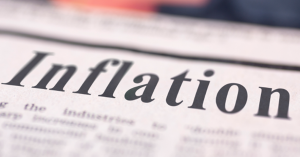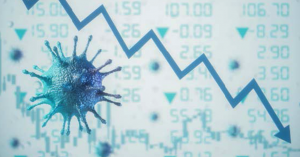
High inflation is the topic de jure as prices continue to rise in the post-pandemic economic recovery. Policy makers, bankers, consumers and business people are all asking whether the current inflationary environment is “transitory” or if inflation is here to stay.
In the latest US Bureau of Labor Statistics report, the US Consumer Price Index rose by 6.2% year over year for the month of October, 2021, the highest level in more than three decades. In this report, gasoline prices were up 50% year over year, and used car prices were up 26% in the same period. Core inflation, which strips out volatile food and energy prices to gain a more accurate picture of the inflationary environment, shows prices rising at 4.6% year over year, which is more than double the trend for the last 25 years.
Economists’ views are mixed in their forecasts regarding the short and long term trajectory of inflation, along with the underlying economic trends causing the upward pressure on prices. Current inflation appears to be primarily driven by pandemic-related causes such as supply chain bottlenecks and disruptions, and a growing economy due to economic stimulus. The debate is whether these pressures will continue, keeping inflation high, or fade over time, returning us to the economic environment we have been accustomed to for the last several decades.
The US Federal Reserve has described the current inflationary environment as “transitory” and has taken a more cautious approach to deploying its tools to fight inflation. The Fed’s argument is that current elevated prices are due to global supply chain disruptions, and as the world returns to normal, these pricing pressures will decrease. During the pandemic, aggregate demand from businesses and consumers drastically shifted towards goods and away from services. Per the Fed, as this demand reallocates across economic sectors and supply chain bottlenecks resolve themselves, the upward pressure on prices should diminish. As a result of this belief, the Fed is taking a cautious approach to inflation, with no plans to raise rates in the near future (which is their primary tool to fight rising prices).
Moreover, many economists argue that the deflationary pressures that plagued the Western world and Japan before the pandemic still exist and will likely persist. Specifically, before the pandemic, these economies struggled with downward pressure on prices caused by high debt levels, an aging work force, increasingly skewed income and wealth distributions, and globalization. These economists argue that all of these downward pressures on prices remain and are unlikely to change.
However, some economists believe that the Fed is not doing enough to fight inflation. These inflation hawks primarily cite the unprecedented economic stimulus in response to COVID-19, from both the Federal government and the Federal Reserve, as having created a surge of cash in the financial system. In response to this argument, inflation doves have cited the sharp narrowing of the fiscal deficit combined with the Fed’s recently announced taper of its stimulative asset purchases . The Fed will reduce such asset purchases beginning in November, 2021 and completely end the program by July, 2022. With the expiration of COVID related benefits, the Federal deficit will shrink from 13% of GDP in 2021 to 5% in 2022, sharply reducing economic spending by the government.
Economists have also expressed concern that the deflationary pressures of globalization had already begun to wane prior to the pandemic as a result of the Trump administration’s sharp change in China trade policy, with the pandemic only reinforcing the need to have more local supply chains. These trends may keep pressure on the supply of goods and the benefits of globalization may be less acute going forward as American workers are no longer competing as fiercely with their low-wage Chinese counterparts for manufacturing jobs.
In addition, high energy prices are likely here to stay as the result of a trifecta of depressed supply, decarbonation initiatives, and a rapidly reopening world continue to upend world energy markets. During the pandemic, the world’s major energy companies slashed their capital budgets which significantly limited their investments in new fossil fuel supplies over the coming years. In addition, these companies are under tremendous pressure from both their shareholders and politicians to decarbonize, further reducing their incentive to invest in new oil and gas wells. This has created an environment where new supplies of oil and gas will be limited in the coming years, creating upward price pressure on what is still the world’s dominant form of energy.
There are countless variables, trends, and data points that support either view regarding pricing pressures going forward. One thing economics can agree on is that the inflation outlook is far from clear, and only time will tell if the current inflationary environment will be a temporary phenomenon, or if inflation will be here for the long term.

By Wesley King
Associate at Frandzel Robins Bloom & Csato, L.C.

With coronavirus cases rising and Washington in partisan gridlock, the likelihood of more aggressive Fed action is rising
As the coronavirus continues to wreak havoc, the US economy faces immense pressure in the near term due to surging Covid-19 cases and the lack of stimulus. Given these significant headwinds, on November 20, 2020, JPMorgan became the first major bank to update its 2021 outlook with negative GDP growth for the first quarter, and growth estimates are expected to continue to be subject to additional downward revisions.
With Washington seemingly unable to address the effects of the coronavirus due to partisan gridlock, the United States Federal Reserve will continue to play an outsize role in the economic recovery. Jerome Powell, the Chairman of the Federal Reserve, indicated in his November 5, 2020 press conference after the last Federal Open Market Committee (FOMC) meeting that current Fed policy was “appropriate,” but “…the accelerating spread of the virus may be changing that assessment…”. On November 5, 2020 the US registered approximately 121,000 new cases of Covid-19. As of November 20, 2020 that number has increased to over 180,000 a day and continues to climb.
Given these concerning trends, the Fed is likely to take more aggressive action to shore up the economy. Moreover, with the United States Treasury Department’s recent request that the Fed wind down several of its emergency lending programs at the end of the year, the Fed has additional impetus to act in the near term.
The central bank has taken unprecedented action since March 2020 to address the Covid-19 crisis. It has already lowered the fed funds rate (the Fed’s main policy tool) to near zero percent. In addition, as part of its quantitative easing program, the Fed has been buying $80 billion of treasury bonds and $40 billion of agency mortgaged-backed securities every month. The Fed has also launched numerous lending programs aimed at market function and lending.
Despite these unprecedented actions, the Fed has a few more options at its disposal that it could announce in the coming months:
- Modifications to the Fed’s Existing Quantitative Easing Program. Quantitative easing is essentially when the central bank prints money to purchase government or other bonds on the open market, with the goal of putting pressure on interest rates. Bonds are affected by supply and demand like anything else, so when a large buyer like the Fed creates demand, bond prices rise resulting in a decline in yields. While the current $120 billion a month quantitative easing program is far larger than the $85 billion monthly peak utilized by the Fed during the Great Recession of 2007-2008, the Fed has appeared open to increasing the size of this program.In fact, after the November 5, 2020 FOMC meeting, Chairman Powell acknowledged the committee had “quite a useful discussion” about options for modifying its bond-buying program. Given that long term treasury yields have risen sharply since the election and the announcement of a successful Covid-19 vaccine, from the 0.50% to 0.70% range since the start of the crisis to close to 1.00% today, the Fed is likely to focus any modifications to its quantitative easing program on purchases of longer term bonds, as the Fed’s current program is spread fairly evenly across the yield curve between short and long term debt.
- The Possibility of Negative Rates. The fed funds rate is a benchmark for other interest rates, so adjusting such rate could lower the cost of mortgages, auto and other loans, while also reducing interest rates on savings accounts. However, the Fed has already reduced the fed funds target rate to near zero percent so the Fed would have to implement negative interest rates to lower rates further. Other central banks around the world, most notably the Bank of Japan and the European Central Bank, have further reduced interest rates to below zero to some success, but to the detriment to their domestic banking industries. Negative rates in the United States would further pressure interest margins at banks, which are already stressed with near zero rates. Given the controversy surrounding negative rates, the Fed has indicated that it is unlikely to pursue negative rates in the future.
- Changes to Forward Guidance. The Fed frequently used “forward guidance” as a tool during the Great Recession, whereby the Fed provided future forecasts of its monetary policy to influence market expectations for interest rates. The Fed can keep interest rates low and stimulate the economy by committing to continue its quantitative easing program, or keeping interest rates at a certain level through a certain date. It is highly likely that the Fed will utilize such tool in the future, and may even indicate that it will allow higher inflation than its usual 2% target until the economy regains its footing. Given that the Fed traditionally raises interest rates to fight inflation, this could have a significant stimulative effect on the economy.
- Yield Curve Control. In addition to the tools described above, the Fed could use another policy tool called “yield curve control” where the Fed commits to buying whatever amount of bonds are necessary to cap long term interest rates. This was done during World War II but has not been utilized by the Fed since 1951. Yield curve control has been used recently by the Bank of Japan and the Reserve Bank of Australia, so it is possible that the Fed will utilize such a program if the economy continues to deteriorate.
- Monetizing the Debt. This is a form of quantitative easing by which the Fed buys debt directly from the government. While similar to quantitative easing, monetizing the debt allows the government to directly finance itself with printed dollars. This policy would be subject to intense debate, as many economics argue that monetizing the debt would potentially create runaway inflation in the economy. The Bank of England has recently agreed to do this to reduce the supply of government bonds in the marketplace, thereby reducing interest rates, but this is highly unlikely to happen in the United States given the political controversy surrounding the idea.
While Chairman Powell has repeatedly emphasized the importance of the fiscal response to handling the Covid-19 crisis, the Fed has shown its willingness and ability to act in times of crisis. Given the current political environment and recent rise in cases, the likelihood of Fed action in the coming weeks is high.

By Wesley King
Associate at Frandzel Robins Bloom & Csato, L.C.

AB 1482 Explained
In early September, 2019, the California legislature passed AB 1482, which would enact a statewide rent-control law and other eviction protections for renters. AB 1482 is part of the State’s efforts to reduce the cost of housing and protect California renters who have been adversely affected by rising rents and gentrification. The law is expected to be signed by Governor Newsom before the end of October, and the law will go into effect on January 1, 2020 and expire in 2030, unless extended by lawmakers.
What does AB 1482 do?
As currently contemplated, AB 1482 will institute state-wide rent control where landlords will be restricted from raising rents by more than 5 percent per year plus the local rate of inflation, with 10 percent being the maximum amount of the increase.
In addition to the rent control provisions, AB 1482 will also require that landlords show “just cause,” such as a failure to pay rent or some other default under the lease, before evicting tenants from a unit that such tenant has resided in for over one year. Moreover, landlords must provide the tenant an opportunity to “cure” the missed payment or default. If a landlord wants to evict a tenant without the aforementioned “just cause,” such as to convert a rental property to condominiums or make other renovations, the landlord will have to pay the evicted tenant a relocation assistance of one month’s rent.
AB 1482 only applies to units that are (i) not already covered by a rent control ordinance, and (ii) greater than 15 years old, which will get adjusted with every passing year (eg: units built in 2006 would be covered in 2021, units built in 2007 would be covered in 2022, and so on). For example, in a city like Los Angeles where the local rent control ordinance only applies to buildings constructed before 1978, as of January 1, 2020, rental units built from 1978 to 2005 would be covered by AB 1482. Moreover, single family home rentals are exempt unless such rentals are owned by an institutional investor.
How will AB 1482 affect the housing market?
According to a study by UC Berkeley’s Terner Center for Housing Innovation, which studied 10 communities throughout the state – Chula Vista, Fresno, Long Beach, Los Angeles, Oakland, San Francisco, San Rafael, Stockton, Vallejo, and West Sacramento – found that a majority of the rent increases over the last several years would have been permitted under AB 1482. However, the study did note several communities, such as Fruitvale/West Oakland, the Mission in San Francisco, and Boyle Heights in Los Angeles, that had exorbitant rent hikes over the period studied. Existing tenants in those areas would have been substantially benefited by the law, with an estimated 32 percent of the units in such areas being covered by the law.
Economists generally view rent control laws as having a detrimental affect on the cost of housing over the long term. While California suffers from an acute shortage of housing, there is little evidence that rent control laws actually increase the supply or affordability of housing. In fact, the opposite may be true – rent control laws deter the supply of new housing as the construction for new homes becomes less profitable. Moreover, landlords are often discouraged from investing in their existing properties as they see less return on their investment, and renters stay put as the disparity between their controlled rent and the market increases over time. These factors create distortions in the housing market.
While economists point to the construction of new units as the primary solution to the shortage of housing in California, such construction is unlikely to happen fast enough to address the current crisis in the State. Accordingly, as recognized by the Berkeley Haas Institute for a Fair and Inclusive Society, rent control is the only way for government to enact immediate solutions to respond to the housing crisis.

By Wesley King
Associate at Frandzel Robins Bloom & Csato, L.C.

As the third and final article in our series on blockchain technology, we will discuss how the burgeoning technology will affect the financial industry.
To review, blockchain in general can be described as a decentralized, shared, public ledger that is maintained by a network of computers that verify and record transactions into the same decentralized, shared, and public ledger. No single user controls the ledger – it is maintained by all of its participates, in the cloud, or by a network of designated computers that collectively keep the ledger up to date and verify its transactions. As such, blockchain creates irrefutable records of transactions, creating trust between counterparties and eliminating the need for clearing houses or middlemen in transaction.
As mentioned in our prior article, modern banks and other financial institutions face the biggest and most sweeping changes as blockchain is implemented across the industry. According to a 2018 report from the accounting firm KPMG, the implementation of blockchain in the financial industry will have numerous major benefits, such as increasing efficiency, reducing loss and fraud, improvement to client/customer experience, and will result in a higher availability of capital. Also as previously discussed, per a 2017 study conducted by Gartner, Inc., it is estimated that the business value-add of blockchain will likely exceed $3.1 trillion by 2030, most of which will accrue in the financial or financial-adjacent industries.
As a financial professional, banker, or even a consumer of financial services, you may be asking yourself, “what do these changes look like?” While “increasing efficiency” may sound esoteric, using a universal and automatically verified ledger for financial transactions within a given entity or marketplace will clearly streamline accounting and auditing systems. Moreover, a universal and irrefutable ledger provided by the implementation of blockchain in a given system has the potential to drastically reduce loss and fraud. However, as we will illustrate, the most exciting implementation of blockchain is coming in the form of new and innovative financial products.
Lawyers, computer programmers and financial professionals all over the world are in the process of developing “smart contracts” that imbed traditional financial products with blockchain technology. These “smart contracts” not only take advantage of the security features provided by blockchain, they provide an opportunity to connect and digitalize every aspect of financial services and transactions. Upon the full realization of blockchain technology, data will be shared across disparate services and technology, from bank accounts to mortgages to smart appliances to regulatory registries, which will all continuously record and cross-check into their own respective universal blockchain ledger. Imagine:
- A mortgage that connects to the blockchain ledger at local the County Recorder’s Office that will automatically notify the lender if an impermissible lien is placed on the property.
- A smart car that will drive itself to a repo lot as soon as there is a 30-day delinquency in the blockchain ledger that records the payments on the loan used to purchase the vehicle.
- A bond that connects automatically to a company’s blockchain ledger and converts to equity upon certain financial performance metrics, which then in turn can automatically pay a dividend based on the number of widgets sold in a given quarter.
- A contract for life insurance that will reduce your monthly payment when your smart watch records exercise activity (or increase your payment when it connects to your bank account and sees one too many fast-food stops).
The beauty of these financial products is that they involve no middlemen and no back-office support, as such transactions will be automatic and seamless. The possible innovations are only limited by the imaginations of creative and tech-savvy lawyers who can marry finance with the complicated technical and legal aspects of implementation.
Fortunately for the banking and financial industry, and the individuals who consume their services, these changes are not going to occur overnight. Given the recent implosion of what is now being referred to as the “Bitcoin bubble,” the notoriously conservative financial industry is likely taking a second look at some of its blockchain initiatives. Moreover, new blockchain dependent financial innovations will have to be proven safe, fair, and reliable to staid regulators.
However, like in all major industry shifts, there eventually will be winners and losers. Just as the internet took traditional retail by storm, slow-moving incumbents will likely suffer relative to their peers who benefited from early adoption of blockchain technology.

By Wesley King
Associate at Frandzel Robins Bloom & Csato, L.C.

As part two of our three part series on blockchain technology, we will provide an overview of the many different applications of blockchain and how it will change a variety of industries. As discussed in our first article, blockchain technology moves far beyond its implementation in Bitcoin digital currency and has the potential to remove middlemen, reduce transaction costs, and make the analysis of data more efficient across a wide variety of industries and applications.
Entertainment and Intellectual Property
Blockchain technology has the potential to revolutionize the way artists get paid and intellectual property is enforced in the entertainment industry. The consumption of media, from television shows to video games and music, can be embedded with blockchain technology so content creators are paid, advertisers have accurate consumption information, and piracy is eliminated. Entertainment executives, along with several artists, such as Imogen Heap, which recently released the first song with blockchain technology built-in, imagine a blockchain system where digital rights are centrally maintained, where creative works can be stored, and consumption tracked. The building blocks for such a system already exists as more and more entertainment is consumed digitally, and artist societies such as ASCAP, SACEM, and PRS have recently begun blockchain initiatives to improve data accuracy for creative rightsholders.
Energy
Blockchain technology has the potential to further upend energy markets, as smaller, green energy projects, such as roof-mounted solar panels or small wind farms, aim to use blockchain sell energy to their neighbors without going through a middleman-power company. Companies such as Electron in the United Kingdom and Power Ledger in Australia are working to implement peer-to-peer energy trading markets, underpinned with blockchain technology, where individuals can buy and sell centricity within “microgrids,” or specific geographic regions. This development could be revolutionary as large, capital intensive electric utilities the world-over are already suffering from the democratization of energy generation through home solar installations. Allowing the efficient tracking of consumption, and efficient transfer of energy on a peer-to-peer level could completely change the way electricity is generated and consumed.
Retail and Inventory Tracking
Walmart and other large retailers are working to deploy blockchain to manage their international procurement inventory operations. Blockchain can be used to create a centralized digital ledger to track a product from the moment its manufactured overseas, to its shipping, warehousing, stocking on a store shelf, and ultimate sale. Such a system has the potential to reduce costs for cross-border transactions, and could eliminate the use of letters of credit and other trade financing instruments. Moreover, just-in-time manufacturing will only be made more efficient, as manufacturers will have access to troves of new data about the transfer of goods through supply channels.
Maintenance Schedules of Automobiles, Other Machinery
Blockchain technology may eventually be embedded in every automobile or other large piece of machinery that is ever manufactured to track maintenance schedules and performance. For example, proponents of the technology envision an era where automobile maintenance is tracked in a centralized ledger, and each automobile automatically updates the blockchain upon every oil change, part replacement, or error code that is generated. Automobile manufacturers will be able to track in real time the performance of their products, finance companies will be able to verify if their collateral is being appropriately maintained, and buyers of used automobiles will be able to know with 100% certainty the history of the vehicle they are buying.
Luxury Goods and Collectibles
As global counterfeiting runs rampant, luxury goods companies are beginning to explore using blockchain technology to reassure customers they are getting the real thing (while protecting companies’ valuable brand equity). Purveyors of luxury goods are establishing centralized ledgers to track the manufacture, sale and ownership of luxury goods. Companies are exploring different ways that blockchain could be embedded in items, such as a Gucci purse or a piece of fine art, that would allow someone to verify its authenticity. Such transparency could invigorate secondary markets for such goods, as buyer will be able to trust the authenticity of otherwise questionable goods they are purchasing.
Finance and Lending
As you can see, there are an endless number of ways blockchain can be implemented across a vast number of industries. Despite the potentially disruptive applications discussed above, the finance industry faces the biggest revolution as a result of the implementation of blockchain technology. As we will discuss more in depth in our part three of this series of articles, the financial industry, from borrowing money to raising capital, and any legal documentation relating to the same, will be irreversibly impacted by blockchain technology.

By Wesley King
Associate at Frandzel Robins Bloom & Csato, L.C.

While Bitcoin may be a bubble or passing fad, the technology behind it will revolutionize the way we do business in the near future
Part I: What is Blockchain?
While Bitcoin became a household name in 2017, most people know little of the technology underpinning the digital currency. This technology, known as “blockchain,” has far reaching implications beyond digital currency, and will likely revolutionize the way we do business in the near future. In a 2017 study conducted by Gartner, Inc., it estimates that the business value-add of blockchain will grow to slightly more than $176 billion by 2025, and will likely exceed $3.1 trillion by 2030. In fact, a World Economic Forum report from September 2015 predicts that by 2025, ten percent of global GDP will be stored on blockchain technology.
In a January, 2017 Harvard Business Review Article titled “The Truth About Blockchain,” professors Marco Iansiti and Karim R. Lakhani describe blockchain as a foundational technology that may not immediately overtake our traditional business models, but has the potential to create new economic and social systems and enormously change the way we transact over the coming decades. Moreover, companies already see the writing on the wall – IBM, Microsoft and Intel are offering blockchain software tools to their business customers, Goldman Sachs, Nasdaq, Walmart, Visa and the State of Delaware all have started blockchain initiatives.
How could such a new and little known technology have such massive business implications? In this series of articles, we will first provide a general overview of what blockchain technology is and how it works. In our second piece, we will provide an overview of how blockchain will change a variety of industries. Finally, in our third piece, we will provide a more in-depth look at how blockchain will impact the legal industry, contracts and financial institutions.
While Bitcoin uses a specific implementation of the blockchain, blockchain in general can be described as a decentralized, shared, public ledger that is maintained by a network of computers that verify and record transactions into the same decentralized, shared, and public ledger. No single user controls the ledger – it is maintained by all of its participates, in the cloud, or by a network of designated computers that collectively keep the ledger up to date and verify its transactions. Bitcoin, as the largest implementation of blockchain technology today, uses competitive “miners,” or individual users that solve ever more difficult math equations with monetary rewards if they are successful, to verify and record transactions.
When a transaction is verified and recorded, the blockchain system sends transaction data to all of the users of the blockchain ledger, thereby ensuring the validity and accuracy of the transaction and prevents one party to the transaction from lying about the details or failing to perform. Each transaction, or “block,” is encrypted into its own original piece of information, which is called a “hash.” Even the slightest modification of data will result in an entirely different hash. For example, in applying SHA256, the encryption algorithm used by Bitcoin, to the number 1000 generates the following hash, “40510175845988F13F6162ED8526F0B09F73384467FA855E1E79B44A56562A58” while the hash for the number “1000.01” generates a wildly different result in “6B481FC35196FA215BB30D39ECB919CE7DE410488EC08D692356E22E5A67B2B9.” Because each hash is unique, it becomes exceptionally difficult to tamper with the system as it is nearly impossible to generate an identical hash to fool the system.
Essentially, blockchain is a tool where trustworthy records of transactions can be kept, verified, and made publicly available. Blockchain is revolutionary because it creates confidence between counterparties and negates the need for neutral third-parties or transactional facilitators, such as escrow companies, government authorities or clearing houses. Transactions are “peer-to-peer,” or directly contracting party to contracting party. If there’s a disagreement, there’s no need to call a lawyer because there is only one database.
The implications of blockchain will be enormous and will impact almost every industry. 2018 is likely to be a huge turning point for blockchain technology and the year we see the technology significantly implemented beyond Bitcoin. As we will discuss in Part II of this article, there are a wide variety of businesses and industries that are currently experimenting with blockchain technology.




